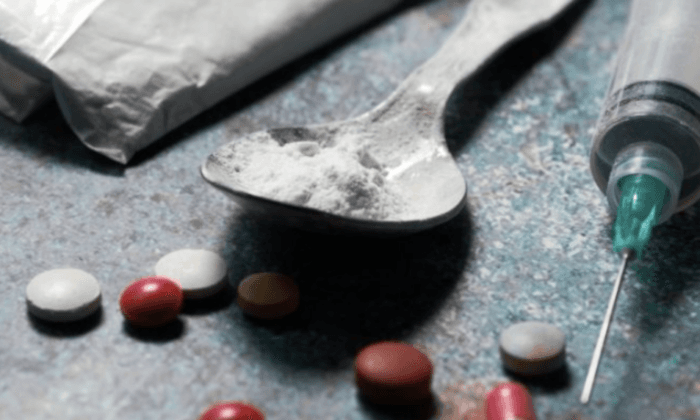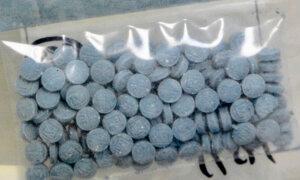Public health authorities are warning of a new fentanyl drug concoction laced with a veterinary sedative that makes it more potent than previous cocktails.
According to a libertarian drug policy analyst, the emergence of this new drug continues an acrimonious relationship between those peddling illicit substances and law enforcement that began in the first chapter of the War on Drugs: Prohibition.
According to the Chicago Department of Public Health (CDPH), medetomidine is more potent than xylazine, also a veterinary sedative that has made it into street narcotics labeled the “zombie drug.”
“Multiple associated drug samples from the West Side of Chicago tested positive for elevated levels of medetomidine,” the CDPH said. “Medetomidine has not previously been detected in Chicago, although it has recently been detected in Philadelphia. In Chicago, medetomidine has been detected in combination with fentanyl, heroin, xylazine, alprazolam, and nitazenes.”
Medetomidine is similar to Precedex in humans and can cause respiratory depression, the CDPH said, adding that its effects can’t be reversed by Naloxone, a medication that restores breathing after an overdose.
‘Iron Law on Prohibition’
“Attempts to rein in illicit fentanyl or control the chemicals used to synthesize it resulted in even more dangerous drugs” that have prompted the appearance of drugs like xylazine and medetomidine, Josh Bloom, director of chemical and pharmaceutical science at the American Council on Science and Health, wrote in a May 2024 article on medetomidine.“Another day, another more dangerous street drug in an unwinnable war,” Mr. Bloom said.
Dr. Jeffrey Singer, a health policy analyst with the libertarian Cato Institute, told The Epoch Times that the emergence of this new drug is unfortunate, but not unexpected.
“This is what we call in the drug policy field the ‘Iron Law of Prohibition,’” Dr. Singer said, further explaining that the theory is that when law enforcement cracks down on illicit substances, their potency and danger only increases.
As an example, Dr. Singer points to the prohibition era from 1920 to 1933, when people turned to harder concentrations of alcoholic beverages when they could no longer legally obtain beer and wine. Another more modern example, he said, is people bringing liquor into stadiums where beer and wine aren’t allowed because the smaller volumes are easier to smuggle.
“Prohibition incentivizes whatever is being prohibited,” Dr. Singer said.
When drug enforcement agencies cracked down on prescription opioids during the Obama administration, heroin then became cheaper and easier to obtain, he said.
Later, fentanyl was used because it increased the potency of heroin and made it easier to smuggle in smaller sizes, he said.
“What really set things off was the pandemic because the border closures and supply chain issues made it difficult to get opium,” he said.
It was also hard to get the supplies used to make opium into heroin, so the cartels began to deal only in fentanyl, which can be synthesized and reproduced in a lab, he said.
Never Enough
But it’s never enough, he said, so the cartels started adding xylazine to increase the potency of fentanyl, and now the more potent medetomidine.“After that, there will be something else,” he said. “There’s always something else.”
There’s already a new class of synthetic opioids, he said, called nitazenes, which is considered 40 times more potent than fentanyl.
Federally Legalized; State Regulated
According to Dr. Singer, prohibited drugs should be federally legalized like alcohol, with it left up to the states to decide if they want to criminalize them. If drugs are legalized, age, public use, and driving while under the influence restrictions could be imposed.“Essentially, we should follow the model we used when we ended alcohol prohibition,” he said. “When I buy an alcohol product in the liquor store, I never worry that it might be tainted with some other drug, like fentanyl, or that it might be of greater percentage alcohol than it states on the label.”
He added that government obstacles should be removed from groups seeking to provide harm-reduction strategies to drug users.
‘Transnational Organizations’
Dr. Singer added that he prefers to no longer call those trafficking drugs “cartels.”Instead, he refers to them as “transnational organizations.”
“Our drug war has made them so powerful and so wealthy that though some of their leaders may be headquartered in some places like Mexico, these cartels have begun partnering with cartels in other countries,” Dr. Singer said.
Plan Columbia, the 1999 U.S. foreign aid initiative to combat Colombian drug cartels in Columbia, only moved the cocaine trade to Central America and Mexico, he said.
“In fact, cocaine has never been more abundant and cheap than it is now, so all they’ve done is move it from one place to the other, and it’s not stopping,” he said.







